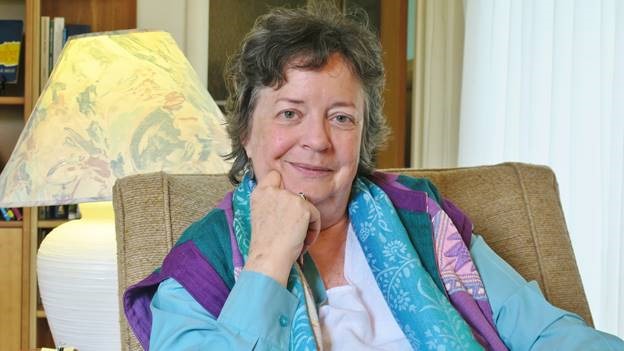The VFP 156 Profile: Elizabeth V. Hallett
(Your editor realizes that this profile is a little lengthy, but he hopes that you will find it interesting and will want to learn about the life & times of this very interesting woman, who is an associate member of Veterans for Peace and our chapter.) — Allen Hallmark

Elizabeth V. Hallett’s activism for peace & justice goes back a long way and her life story is a fascinating one with many twists and turns, travels and travails along the way.
Many of you probably know that Elizabeth is the current chair of the Peace House Board of Directors, having followed Herb Rothschild in that role in January 2016, but did you know that she served as executive director of Peace House from 1993 to ’96 and served another year (1997) as co-director with Ruth Coulthard after that?
Like many folks of a certain age, Elizabeth’s activism began during the Vietnam War, when she was a college student at Miami University of Ohio, where she graduated in 1969 with a degree in American Studies and minors in Portuguese and French. She’s a whiz with foreign languages and is fluent in Portuguese and Spanish to this day.
Miami University, located in the small town of Oxford about 40 miles north of Cincinnati, was not a hotbed of anti-Vietnam War fervor. Elizabeth says that only a maximum of 40 students and faculty members participated in anti-war demonstrations while she was there. But the Vietnam War, its devastations and her participation in the protests against it were a big influence on her life and informed much of her later activism.
In 1987, through her friendship with midwife Holley Rauen, Elizabeth met S. Brian Willson, the self-styled “peace warrior.” Together, Brian and Holley were part of a group called the Nuremberg Actions Vigil, protesting munitions shipments from the Concord Naval Weapons Station in California beginning in early June or 1987. It was to see 2500 arrests and 62 court cases over the span of several years. On Sept. 1, 1987, when involved in an intentional and pre-announced nonviolent action to block a weapons shipment leaving the naval base, Brian Willson was run over by a military train, costing him both his legs — amputated below the knees. That he survived was miraculous. Holley and Brian had married just 10 days before the train ran over Brian. The Nuremberg Actions Vigil was based upon the charge for citizens to protest and resist crimes against war, crimes against humanity, and crimes against peace. It was the basis of the Nuremberg Trials of Nazis in Germany in 1947 and 1948. What had been an eight-hour-a-day vigil during the summer of 1987 became a 24-hour hour vigil after September 1st.
The Nuremberg Actions Vigil assumed a moral responsibility in holding the US government responsible for the deaths of thousands of people in Guatemala, El Salvador, Chile, Nicaragua, Honduras for examples, due to documented weapons sales and US military trainings of Latin American military leaders that were repressing and killing people in those countries.
Elizabeth joined the vigil and became a support person. The goal of the Vigil was an end to the stream of munitions leaving the weapons station for Central America in support of the Contras (right-wing troops fighting against democratic forces for control of El Salvador and Nicaragua). Over four million dollars in white phosphorous rockets, grenades and other weapons were sent to El Salvador in one shipment alone, for which the Vigil had documentation. “The vigil awoke my feelings about the Vietnam War and really connected me to my moral matrix,” Elizabeth says of her reasons for joining the protests. Often those involved in nonviolent resistance were treated brutally by police, despite the nonviolent behavior of most of the protesters.
Being three months pregnant in September of 1987, Elizabeth served in a support capacity. On the day that Willson was hit by the train, Elizabeth received a call giving her the chilling news about Brian’s being hit by the locomotive. Due to the severity of his injuries, Brian was in John Muir hospital in nearby Walnut Creek for 30 days. When he returned home, Elizabeth worked with Brian and Holley, coordinating their schedules and some personal care for Holley’s son. The family and those in the Nuremberg Actions Vigil were all trying to recover from the shock of being the train incident, in which the engineer knowingly ran over or assaulted Brian, accelerating to over three times the legal speed, rather than stopping the train.
As news spread about what happened to Brian, phone calls started pouring in from all over the country and from foreign lands as well. Elizabeth answered many of these calls, including one from Rosario Murillo, the wife of President Daniel Ortega of Nicaragua. He was the leader of the Sandinista National Liberation Front, and of the successful revolution that overthrew the government of dictator Anastasio Somoza in 1979. Ortega’s wife asked about Brian Willson’s condition and after Elizabeth explained, Ortega’s wife put him on the phone. He began by saying: “Your pain is our pain.”
Nuremberg Actions had launched the protest at Concord National Weapons Station in June 1987 as a two-day event, Elizabeth remembers, but the police response had been so violent and repressive that a decision was made to keep protesting day-after-day. Many different spiritual communities and peace groups joined the protests and each group would have its day to lead the protest. The peace vigil was an Interfaith undertaking. Each day began with prayers and a ceremony of some kind and then the protesters would participate in the direct action of blocking the road with their bodies at the entrance to the base, so that trucks could not enter or leave the base.
In order to participate in the direct action, Elizabeth says, volunteers had to sign a very specific agreement, stating that they promised to refrain from violent behavior and to not damage property, even if provoked by the authorities. Nonviolence was paramount.
However, there was one group that participated in the demonstration whose members would not sign the agreement. That was the Global Peace Farmers, an all-female group. Their tactics involved cutting the barbed wire fences (which was considered property destruction) around the base and throwing double ladders over the wire. They would then climb into the base, heading into a secured area where nuclear weapons were said to be stored and plant seeds symbolic of life and resistance to the violence and destruction of life that is caused by warfare.
Elizabeth continued to work with Brian and Holley until February 1988 when Holley Rauen urged her to stop working and prepare to have her baby. Elizabeth’s daughter Rachel was born on March 18, 1988. There was a period from 1987-1993 in which Elizabeth collected many stories and interviews about veterans, teachers, religious leaders, artists, and medical professionals who turned to the peace activism and nonviolence of the Nuremberg Actions Vigil, in their anguish over wars in Central America and then later in Iraq.
By October 1988 Elizabeth and her partner, David Ralston, realized that they needed to find a less expensive place to live than San Francisco. After vacationing in Oregon, they decided to move to Jacksonville. A couple of years later, Elizabeth and David separated, while continuing to share in parenting their daughter. With time, they each moved to Ashland: Elizabeth to work at Peace House and David to co-own a books and antiques store. It is now called Antiquarium: a fascinating shop on Main Street in downtown Ashland.
….
Elizabeth V. Hallett was born in Minneapolis, MN, but soon moved to Buffalo, NY, with her parents Leslie & Elizabeth R. Hallett. Leslie Hallett was an ordained Episcopalian priest.
When Elizabeth was 7 years old, the family moved to Belém, Brazil, a large port city on the Amazon river, where her father served a three-year mission for the church. It seems that those three years had a big impact on young Elizabeth’s life. It opened her eyes to other cultures and she found she has a talent for learning languages. She learned to speak Portuguese in Belém and says she is still fluent in that language today.
In 1958, the family moved to Cleveland, OH, where her father became a hospital chaplain when Elizabeth was 10. She spent 8th through 12th grades at Laurel School in Shaker Heights, Ohio on a scholarship, where she studied Latin, French and Spanish (which she has learned to speak fluently). The school afforded her an excellent classical education she recalls with gratitude.
Elizabeth graduated from Miami University in Oxford, OH, in 1969 having spent six months in Brazil teaching English in Porto Alegre. With a bachelor’s degree in American Studies and minors in Portuguese and French, she was hoping to get a State Department job as a Portuguese interpreter, but that didn’t pan out.
So, she got a job in the Community Development Department of the city of Cleveland. Her office was across the street from the local Federal Building and US military induction center. There were still troops being sent to Vietnam. Every day she saw busloads of young men her age climbing onto buses headed to boot camp, and dreaded the fact that she knew many would not return form Vietnam.
In 1971 Elizabeth made her first move to the West Coast and settled in San Francisco for a few years, later moving “back to the land” and living in Calaveras County, doing a variety of jobs and becoming a good organic gardener. Then, in the late 1970s she moved back East to Minnesota, where she got involved with a women’s clothing collective and began to attend homebirths as a doula. Elizabeth became a childbirth educator and part of the burgeoning home birth movement, perhaps influenced by her mother, who was a registered nurse and a childbirth educator.
In 1981, she moved back to California and went to work for the California Association of Midwives. She co-authored a small book in the mid-1980s entitled “Midwife Means ‘With Woman’” to educate people about midwifery. As publicity manager for the association, she worked hard to get an initiative passed to allow midwives to be certified without having to have a nursing degree. It took five initiatives before that finally became law in California.
Elizabeth attended many births as an assistant to the attending midwife over a ten-year period, and she continued to teach childbirth education after moving to Oregon in 1988.
In 1992, Elizabeth had the opportunity to return to Brazil when the Community for the Practice of Nonviolence, which included Brian Willson, asked her to accompany its delegation visiting human rights groups in Brazil as part of a larger tour, to see how the 500th anniversary of Christopher Columbus’ invasion of the New World was being observed throughout the Americas. She acted as Portuguese interpreter for the delegation. Her fourth time in Brazil, it was a whirlwind tour that lasted only two weeks with visits to many areas of Brazil, including a very short stay in Belém. Her tenure at Peace House followed from 1993 through 1997.
After leaving the job as co-executive director of Peace House, Elizabeth hung out her shingle and became a Reiki facilitator in Ashland for a couple of years and spent time writing about the Nuremberg Actions Vigil and transcribing interviews for a book that has not been published.
Then, in 1999, Ashland Community Hospital hired Elizabeth to direct its now defunct respite program for seniors. The program, which operated for fifteen years altogether, provided care for participants with dementia two days a week at Trinity Episcopal Church, giving their family caregivers a respite and encouraging the participants to interact with others in a safe and compassionate environment. They received a hot meal each day.
Under Elizabeth’s leadership, the program expanded to four days a week and moved into a space in the Mountain Meadows Community, because it outgrew the space at Trinity Church. The program attracted lots of volunteers, including musicians, who cared for and entertained the participants.
When Ashland Community Hospital experienced severe financial problems during the Great Recession in 2009, it chose to close the respite program for seniors as a cost-cutting measure, leaving Elizabeth and six other staff members out of work.
Being resourceful, Elizabeth started her own business in 2009, consulting with families of dementia patients and facilitating weekly support groups for dementia patients and care providers. She also assists in care management for families living with dementia due to Alzheimer’s, stroke or other neurological disease. She still believes that respite care would go a long way to soothing the isolation and emotional issues such families face by creating communities of support.
From 2006-2008, Elizabeth was among about 100 health care professionals in Southern Oregon area who have been trained to work with families dealing with end-of-life issues, through a program called the Anamcara Project. It was taught by Richard Groves, through his nonprofit, called the Sacred Art of Living and Dying Center in Bend, OR.
Lately Elizabeth has been studying for a certificate in Spiritual Direction from the Interfaith Chaplaincy Institute of Berkeley, CA. She is also a trained mediator and participates as a trained member of in the Social Artistry program under the Jean Houston Foundation of Ashland.
“I’m an interfaith gal,” Elizabeth says. “I don’t seem to land in any one spiritual faith. I am concerned about the ways in which religious zeal can interfere with a unitive sense of what it is to be in community with each other and be in touch with our spiritual nature as human beings.” What she really loves is working one-one-one or in small groups with people, helping them explore their personal journey through life. As an activist, she also believes in diversity and supporting human rights for all people.
What a full and interesting life Elizabeth has lived!


